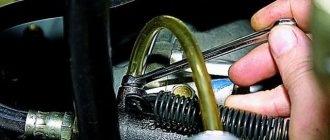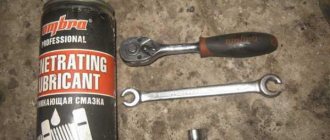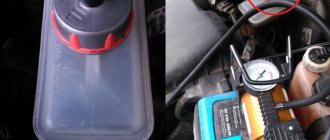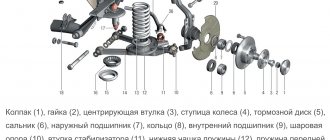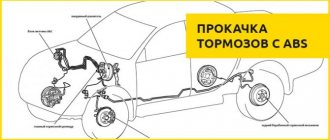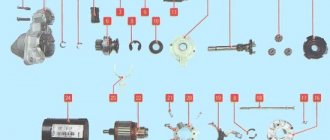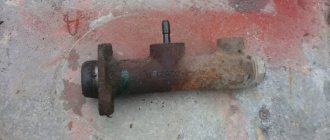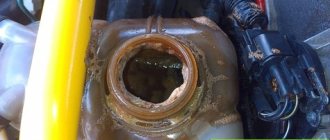The design of the VAZ 2107 car uses a braking system, on the serviceability of which the safety of the driver and passengers depends. This system consists of a large number of different parts, and an important role is assigned to the brake fluid reservoir of the VAZ 2107. This is a special container into which a special liquid mass is poured, which takes an active part in the operation of the system.
Where should I pour the liquid?
In order to fill this same liquid, you first need to find a tank for it. By the way, many cannot find it the first time and without outside help. Before you fill in a new fuel fluid, you need to get rid of the old one. To do this, use a syringe or similar means to clean the tank, and then use any clean cloth to remove the remaining sediment on its bottom and walls.
It is clear that this liquid must be poured very carefully, since contact with the exterior paint of the car can lead to damage. If you do not properly clean the reservoir of the previous brake substance, then small particles such as dust in the future may well cause a complete failure of the corresponding system. If the level of the substance in the reservoir is low, it is necessary to immediately check the integrity of the brake hose, as the cause may be a leak.
In general, the braking system is considered closed, although air enters it when the brake pedal is pressed, but it is completely pushed out when it is smoothly released. This feature of the system allows the liquid to be stored for a very long time and it is recommended to replace it only after two or even three years.
It's no secret that all substances need timely replacement. All necessary data is usually collected in the vehicle's operating manual. In addition to time, another factor in the need to replace brake fluid is mileage.
After driving forty thousand kilometers, you need to at least check the serviceability of the braking system.
How does braking occur in a VAZ 2107
After pressing the brake pedal, the pressure inside the system increases, kinetic energy is transferred from the pedal to the working cylinders. As a result, the pads and disc are compressed, the car slows down and stops.
A fuel fluid that has lost its properties often leads to brake failure, jamming of the working cylinders, and depressurization of the circuit. When driving at high speeds, this is fraught with an emergency situation, a collision with oncoming traffic.
Note to the driver. Carry out preventive work with gloves. TJ is an aggressive environment and causes allergic reactions when it comes into contact with the skin. Wash your hands with running water and soap.
The volume of fuel fluid recommended by the manufacturer in the VAZ 2107 is 1.0 liter. During the operation of a technical product, topping up is often required for various reasons. Buy DOT-4 with a reserve of at least one and a half liters in total volume. When purchasing, check the class type of base TZh. Do not mix synthetics with mineral ones.
Brake fluid reservoir location
The brake fluid reservoir is located in the engine compartment of the vehicle. In order to see it, you need to open the hood. The tank is usually located in an easily accessible, visible place. This is due to the fact that during the operation of the car the brake fluid level should be periodically monitored, topped up or changed.
ATTENTION! A completely simple way to reduce fuel consumption has been found! Don't believe me? An auto mechanic with 15 years of experience also didn’t believe it until he tried it. And now he saves 35,000 rubles a year on gasoline! Read more"
Brake fluid reservoir location
Still, there are cars where the tank is not so easy to detect. It is hidden in the depths of the engine compartment and is often covered with decorative panels, other components or parts. To find the tank in this case, it is recommended to refer to the technical description of the specific car.
Brake fluid reservoir hidden from easy access
Features of the braking system
One of the features of the VAZ-2107 brake circuit is the presence of a dual-circuit system. The essence of a dual-circuit system is that the working drive is divided into two parts, each of which supplies fluid to only two mechanisms, while the circuits do not interact with each other.
The presence of two circuits ensures the operability of the brakes of at least two wheels in the event of depressurization of one of the circuits. That is, even if the pipelines of one circuit are punctured, the second will remain fully operational, which will ensure the functioning of the brakes.
In the VAZ-2107, the circuits are divided in such a way that the drive of the front axle mechanisms is separated from the drive of the rear mechanisms. This allows you not only to maintain the functionality of the system when one of the circuits fails, but also to pump each circuit separately. That is, if one of the circuits is airy, then it needs to be pumped, but it is not necessary to service the second one.
This is only general information about how the VAZ-2107 brake system works, and does not include all the details on its maintenance and repair. In general, the brakes of this car work quite well, although some elements of it cause complaints from car owners.
Article on the topic - Bleeding VAZ brakes
How to find it in Hyundai?
When using a Hyundai car, you need to periodically check the volume of brake fluid. If necessary, add fluid to the tank. The reservoir into which the brake fluid must be filled is located on the main cylinder, on the left side of the engine compartment.
In order to avoid the costs of repairing the brake system, or even the entire car, in the future, change the used working fluid with a new one in a timely manner . Brake fluid is highly hygroscopic (absorbs moisture from the air). This not only increases the corrosive effect on spare parts, but also reduces the boiling point of the liquid itself. This may cause the braking system to stop working. Do not re-apply the drill. It contains too much dirt, air and moisture.
We recommend: The principle of operation of the electric window and the causes of failure
Rear axle brake mechanism
The brake system of the VAZ-2107 rear axle has a different device. All its elements are hidden inside the brake drum:
The working brake cylinder of the VAZ 2107 has the following device: there is a body, also known as a cylinder, with two pistons placed in it. When exposed to fluid pressure, they come out of the cylinder.
The pads are metal, made in the shape of crescents, with friction clutches glued to their upper edge. The pads installed on the hub form a ring.
In the lower part, the pads are installed in the seats made under them, and in the upper part - in the grooves made in the pistons. To prevent the pads from moving apart spontaneously, they are tightened with springs. The parking brake mechanism is also located there.
On top of all this there is a drum mounted on the hub shaft. When braking, the fluid pushes the pistons, and since the pads fit into their grooves, this movement of the pistons is accompanied by the divergence of the pads. At the same time, they are pressed towards the drum and the rotation slows down.
Purpose of the container
The design of the domestic VAZ 2107 car uses a hydraulic braking system, consisting of drive and actuator mechanisms, as well as lines in the form of tubes and hoses, and a reservoir filled with liquid. This liquid substance acts as a drive source, and it is called brake fluid - an acid that is hygroscopic. It is poured into a transparent plastic container under the hood, but more on that.
The container in question on the seven is made of soft and impact-resistant plastic. It is almost impossible to break the tank, but it is easy to damage it with a sharp tool. The reservoir is filled with fluid, which goes to the master cylinder. The piston moves in the cylinder when the middle pedal is pressed, thereby increasing the pressure in the system. When the pressure increases, the working cylinders are activated, in which the pistons move under the action of a liquid substance.
From a brief description of the principle of operation of the brake system on the VAZ 2107, it is clear that the reservoir plays a fundamental role. It ensures an uninterrupted supply of working substance to the main cylinder of the system. If lines or operating mechanisms are damaged, the tightness of the system is compromised. Due to the fact that the tank has transparent walls, it is possible to identify system malfunctions easily and quickly. To do this, you need to open the hood and look to see if the container is full.
How to change the tank
Before replacing the brake fluid reservoir, you need to understand its location. The reservoir is located on the driver's side under the hood. When you open the hood, you need to look at the wall closest to the cabin, where there will be two plastic tanks next to each other. The first reservoir, which is located to the left, is a container for brake fluid. Next to this tank there is another tank of a smaller volume - this is a container for a similar substance, which is used in the clutch system.
Vehicle owners should be aware that brake fluid must be replaced every 40 thousand km. If the car has mileage above this indicator, then the quality of the mixture deteriorates, which can cause brake failure at any time. In addition to replacing the mixture every 40,000 km, it is also necessary to periodically monitor the level of brake fluid in the reservoir and, if necessary, top it up.
Signs of brake fluid loss of quality
- Increasing the length of the path to a complete stop of the car;
- Pressing the brake pedal requires force;
- The pillbox in the expansion tank changed color from light to dark;
- At the place where the tank is installed, traces of lubricant leakage are visible, the level is below normal;
- The yellow indicator on the dashboard indicates the fluid level sensor in the system.
If one or more signs are detected, stop the car, turn off the engine, and inspect the brake circuit and master cylinder. Subsequent operation of the technical device is unsafe.
Fluid replacement tips
Now that we have figured out where exactly it is necessary to fill the fuel fluid, the next step is to choose between contacting the service or replacing it on our own, but not without an assistant. Of course, every more or less high-quality and serious car service center has all the necessary equipment to perform such a braking operation. Thus, the replacement time will be no more than twenty minutes, and its cost will not be too high. Manual replacement takes up to two hours.
Having determined where the brake fluid reservoir is located, first of all, use a tester to check its quality. For example, electronic testers immediately show the boiling point of the fuel fluid, and if it exceeds one hundred and seventy-five degrees Celsius, then everything is fine, but if it is below one hundred and sixty-five, then things are bad and intervention is required.
You also cannot do without an instruction manual, because each car has its own characteristics, and thanks to it you will understand how and where to fill the fluid. But you need to understand that if your car does not include an ABC or a block of corresponding ABC hydraulic valves in its structure, the hydraulic accumulator and pump itself are a single unit, manual intervention is quite possible. If you have an integral type ABC, it is best to visit a car service center.
We recommend: What is Tiptronic automatic transmission and how does it work
Replacing an old vehicle with a new one is carried out carefully and one by one in the circuits of the vehicle. The first in line for this process is the wheel located away from the main cylinder of the vehicle. Therefore, there is a parallel circuit diagram and a diagonal one. The first is a replacement of the TJ in the right rear wheel, left rear, right front and left front. As for the diagonal scheme, the procedure is carried out diagonally: right rear - left front and left rear - right front.
Before adding new fluid, all wheels must be removed, and the car itself must be placed over a pit for inspection. Using a jack, you can also carry out all stages of repair, but the convenience of the process directly depends on the position of the brake cylinder bleeder fittings.
Having removed the wheels and figured out where to fill the brake fluid, the next step is to pour it into the reservoir to the full line and replace the cap. After this, you need to pump the brakes by pressing the pedal at least fifteen times so that the fuel fluid spreads throughout the entire system.
In general, for a complete repair it is necessary not only to find out where the brake fluid reservoir is located, but also to acquire the following things:
- Two pairs of stand-up goats;
- Box type wrench;
- Completely clean plastic pipe;
- High-quality TZ;
- A syringe or other suction device;
- Brake cleaner;
- Clean and fairly soft fabric;
- Container for old liquid;
- WD-40.
How to properly fill brake fluid on a VAZ 2107
Preparatory stage:
- DOT-4 in a volume of 1.0 – 1.5 liters, with a reserve in the tank;
- plastic container to change waste;
- rubber hose;
- key to “10”;
- rags;
- flashlight;
- new boots on the working cylinders as needed.
Sequencing:
- Install the machine above the inspection hole;
- Open the hood, unscrew the cap from the expansion tank of the master brake cylinder;
- Bleed the brake pedal, hold it in the lower position (assistant function);
- Remove the rubber cap on the working cylinder, put the hose on the grease fitting, and lower the end into a plastic container;
- Using the key “10”, unscrew the grease fitting, drain the fuel fluid, tighten the valve;
- Repeat the procedure with pumping until light DOT-4 liquid flows from the hose.
3 flushes are enough to completely update the system. After each cycle, replenish the missing amount of DOT - 4 in the expansion tank. After updating the contour of one working cylinder, we move on to the next. DIY replacement completed.
We pump the front and rear brake circuits according to an identical scheme; there are no fundamental differences.
Where is the brake fluid reservoir located?
In the domestic VAZ car, the brake fluid reservoir is located in the engine compartment (on the left) and is secured with a clamp to the partition. A decrease in the volume of working fluid in the reservoir when the hydraulic brake drive system is sealed is a sign of worn out pads.
Knowing where the brake fluid reservoir is located, you can easily replace the brake fluid with fresh fluid. Remember to replace regularly. Thanks to this, you can maximize the operating life of your own machine.
The principle of operation of the VAZ-2107 brake system
If it is necessary to reduce speed, the driver presses the pedal. Its force is transmitted to the amplifier valve, which opens the required channel to supply atmospheric pressure to the membrane. The membrane is connected to a rod connected to the piston of the main cylinder. This rod displaces fluid into the pipelines leading to the operating mechanisms. Since the liquid is not compressed, all force is completely transferred to the mechanisms.
The liquid presses on the pistons of the working cylinders, and as they move out, they unclench (on drum bellows) or press the pads (on disk bellows) to the disk or drum connected to the wheel hubs. Due to the friction of the pads on the discs (drums), the rotation slows down.
Soft and stiff brake pedal
The normal position of the brake pedal of the 2107 model is when there are no jerks or dips when pressed, and no effort is required. At the same time, during the operation of the car, car owners are sometimes faced with the fact that the brake pedal manifests itself in a completely different way, that is, it becomes too tight or soft. Such manifestations are unacceptable and indicate problems in the braking system. Therefore, prompt repairs are required. Often the pedal becomes soft when the system is too airy. This phenomenon is also called failure. The damage can be repaired by bleeding the brakes, that is, it is necessary to remove accumulated air from the system. The latter could have happened due to the following reasons:
- not enough fuel fluid in the expansion tank;
- sealing in the braking system is broken;
- damage to the brake cylinder.
At the same time, there is a situation where when pressing the pedal it requires excessive force, for which the vacuum booster (VA) is to blame. This mechanism creates a vacuum in the manifold (intake). The fact that the pedal is tight is indicated by a number of reasons:
- the VU air filter is clogged, therefore, it needs to be replaced;
- the VU valve body is jammed; the vacuum booster should be replaced;
- the VU diaphragm is damaged; replacement of the control unit is required;
- wear of the tip of the device; the tip needs to be replaced;
- incorrect operation of the check valve in the control unit; it is worth replacing;
- the seal is broken; the VU or check valve should be replaced;
- damage to the hose connecting the intake manifold and the intake manifold, or the tightening of the clamp in it is loose;
- increasing the size of cuff cylinders in brake cylinders; this happens when using poor quality fuel fluid.
General structure of the vehicle
The diagram of the brake system of the VAZ 2107 car consists of two main components - the drive mechanism and the brake actuators. Due to the drive mechanism, a braking signal is sent to the actuators, thereby bringing the vehicle to a complete stop or reducing the speed.
Braking is performed by increasing the friction energy of friction units with rotating parts. The brake system of the VAZ 2107 is designed in the traditional version:
- The front part is implemented through the use of disc brakes, which are considered one of the most reliable.
- The rear part is equipped with drum devices, the operation of which is also based on friction force.
The brake system drive can be of different types, but the seven uses exclusively a hydraulic type. The hydraulic drive system uses fluid, which acts as the basis of the VAZ 2107 brake system. Brake fluid has the necessary characteristics and is used as a conductor to transmit force from the brake pedal to the actuators - the pads.
